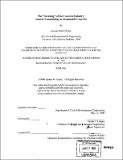The "greening" of the concrete industry : factors contributing to sustainable concrete
Author(s)
Kuntz, Lauren Midori
DownloadFull printable version (6.485Mb)
Other Contributors
Massachusetts Institute of Technology. Dept. of Civil and Environmental Engineering.
Advisor
Jerome J. Connor.
Terms of use
Metadata
Show full item recordAbstract
The dawn of the new millennium has brought to light the environmental concerns of global warming, pollution, limited landfill space, and depleting natural resources. These concerns, compounded by the growing global population, have peaked interests in sustainability. In order to accommodate the world's people, industrialization and urbanization is at an all-time high, making the construction industry one of the biggest consumers of energy and resources and one of the biggest producers of waste. With its versatility and low cost of materials, construction, and maintenance, concrete has emerged as the material of choice for new construction in the 20th and 21st centuries. With over 10 billion tons of concrete being produced annually, the concrete industry is the largest consumer of natural resources and one of the biggest contributors to greenhouse gas emissions worldwide. In order to reduce the harmful impacts of such a valuable construction material, it is imperative that the concrete industry take strides to become a "green" material. (cont.) This paper outlines strategies to reduce the environmental impacts of concrete through recycling, conservation, industrial ecology, and creating more durable structures. Not only do these methods contribute to the reduction of carbon-dioxide emissions through reducing Portland cement production and saving valuable natural resources by conserving water and using alternatives to natural aggregates in concrete mix-designs, but they also strive to create more durable structures to minimize the need for future construction.
Description
Thesis (M. Eng.)--Massachusetts Institute of Technology, Dept. of Civil and Environmental Engineering, 2006. Includes bibliographical references (leaves 40-41).
Date issued
2006Department
Massachusetts Institute of Technology. Department of Civil and Environmental EngineeringPublisher
Massachusetts Institute of Technology
Keywords
Civil and Environmental Engineering.